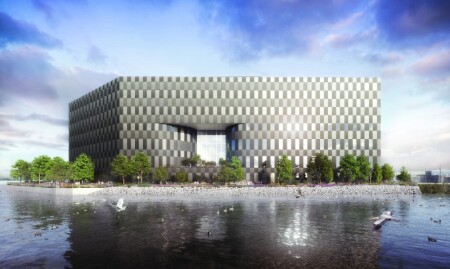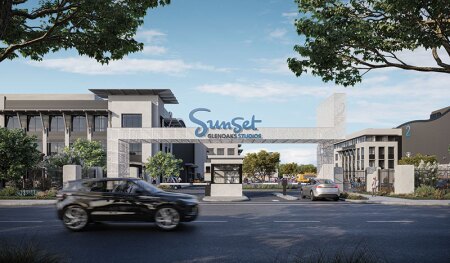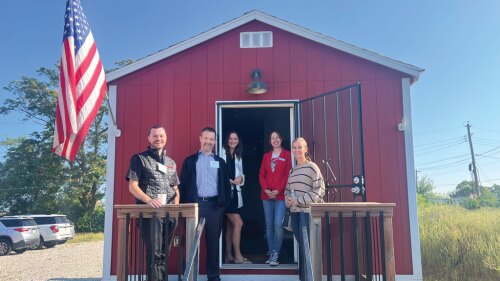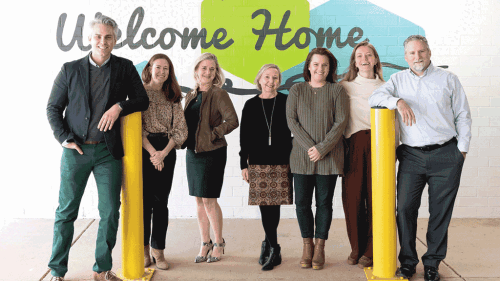Hollywood and the film industry have changed dramatically over the last several decades, especially in recent years with the rise of streaming networks.
Once upon a time, just a few film studios ruled the industry, and the design of the production complexes was utilitarian, as their structures didn’t exactly make aesthetics a priority. But as production needs have changed over time, the way the studios look, feel, and function has begun to change with them. And a new generation of studios and soundstages is taking shape in Los Angeles, and around the country, facilities that are more high-tech, sustainable, and thoughtfully designed to connect with surrounding communities.
RELATED: The Future of Entertainment and Creative Production Space
The wave of new facilities is being driven by the soaring demand for content that has become the norm in Hollywood over the past few years. As a result, numerous high-profile investors are betting big on production studios, including Blackstone, which acquired nearly half of Hudson Pacific Properties’ Los Angeles studios in 2020, and Bain Real Estate Capital, which announced plans to build more than 1 million square feet (93,000 sq m) of new film studios in Hollywood, alongside joint venture partner Bardas Investment Group.
The soundstage market accounts for tens of millions of square feet of real estate. Los Angeles leads the world in the number of soundstage facilities, and from a square-footage perspective as well, with 445 certified soundstages, 64 certified production facilities, and a total of 6.2 million square feet of certified stage space, according to FilmLA’s most recent Sound Stage Study. To put that in perspective, the entire United Kingdom has a total of 5.4 million square feet, Ontario has 3.8 million square feet, and New York has 2.8 million square feet of soundstage space.
Stay-at-home orders during the first several months of the pandemic pushed the growth of streaming platforms significantly. In 2020, for the first time ever, the number of subscriptions to streaming services surpassed 1 billion to reach 1.1 billion globally, marking a growth of 26 percent year-over-year, according to a report from the Motion Picture Association. As a result, production facilities have been a boon to commercial real estate markets. In most of the major markets for filming, vacancy rates have persistently stayed in the single digits, and production companies are increasingly looking to lock down longer-term leases. “The advent of streaming has created seemingly insatiable demand for content with downstream effects for real estate,” CBRE wrote in the fall of 2020. “The top five streaming companies invested a staggering $25 billion in new productions in 2019 alone.”
However, as more people have chosen subscription streaming services over cable, it hasn’t necessarily meant more profit for the companies that make streaming content. Many traditional media and entertainment companies have reported losses since early 2020 on their streaming platform businesses, according to the Wall Street Journal. Earlier this year, before the strikes in Hollywood began, the struggles with profitability, coupled with a weakened ad market, had led many companies to institute layoffs.
The surge in demand for studio space led to a hike in rental rates. Among soundstages owned by Hudson Pacific Properties, rents rose 20 percent between 2017 and 2020. At the firm’s Sunset Las Palmas property, average rent per square foot was $51.84 ($556 per sq m) in 2020, an increase of nearly $10 per square foot from 2017.
As film studios look to build more soundstages to meet the increased demand from streaming networks, the neighborhoods where they are rising could experience major transformations. That was certainly the case for Long Island City, a formerly industrial waterfront neighborhood in Queens, New York. In the 1980s, brothers Stuart and Alan Suna turned a former bread factory there into Silvercup Studios, a major production facility that has been the primary filming spot for some of TV’s most popular shows over the last 40 years, including The Sopranos and Sex and the City. The facility has helped turn the neighborhood into a hip area, with numerous luxury rental towers popping up along the waterfront during the last decade.
Improving on the past
Modernizing film and production studios has meant moving away from massive facilities, built to resemble factories for moviemaking, to buildings that, while still large and capable of providing for all the typical production needs, are designed to make quality of life at the studios more integral.
“Traditionally, studios were fortified worlds for production,” says Andy Lantz, partner and creative director at RIOS, a Los Angeles–based global design studio that is currently involved in designing several Hollywood film studios. “Our main emphasis when we get brought in is the human component of how it can be much more than just a black box.”
Advances in technology and production needs have changed in the decades since Hollywood’s early days, and that means how studio complexes are designed will need to change, too. “There’s a lot of inefficiencies with studios constructed a long time ago,” says Chris Barton, executive vice president for development & capital investments at Hudson Pacific. “They weren’t necessarily built with the ratios in mind that we see today.”
It can all boil down to ratios and demand, Barton further explains: if four shows want to come in and use a studio, each would have a different ratio of stages to office use to production use space, as well as what’s referred to in the industry as base camp space, or outdoor space used for the backlot, truck assembly, and a whole host of other needs. “The way that studios perform their productions is a lot different today than many years ago,” Barton says. “The nice thing about these projects is [that] you get a chance to kind of get it right.”
A lot of what goes into building the new studios today is thinking about the needs for tomorrow. “You’re trying to future-proof them,” Barton says. Creating flexibility for these new spaces is crucial in ensuring that, regardless of what user occupies the space, it can easily be reconfigured and adapted to work for their specific needs. Stages these days need to cater to a much wider array of productions. One way to prepare for those different needs is by providing more power than what has typically been available in a soundstage. Usually, studio power requirements are geared more toward intermittent power.
“You have to have significant power for huge spikes in power usage occurring during production,” Barton says, “but so much of the time the studio does not require significant power, which occurs when sets are being built out … between shoot days and prep days and all other nonproduction days on the lot.”
Projects leading the way
As Hollywood’s biggest studios look to revamp their soundstages and lots, some of the most well-known architects and developers in commercial real estate are being tapped to help bring these visions to life. Fox Corporation is overhauling its historic Fox Studio Lot, which originally started construction in the late 1920s. RIOS has its hand in designing several projects that involve redeveloping or adding more soundstage and production space. One of those projects is the $1.5 billion redevelopment of the Fox Studio Lot at the site of the former 20th Century Fox lot in Century City.
Like a lot of major studios, Fox recognized the need for more space at its complex to meet streaming needs. The project calls for more than 1.5 million square feet (140,000 sq m) of added space, including 11 soundstages, and a couple of sizable office and support buildings. Projects like this one can spend years in the entitlement process with the city of Los Angeles to get properly titled, but things are moving along well. “One thing about this town is that many people are so connected with the industry, there’s a lot of general support for it,” says Robert Hale, creative director and partner at RIOS. “So it’s been a good thing.”
The rethinking of studios and soundstages during an era when streaming has led to a boom in content has led to architects and developers being much more thoughtful about spaces and how they are used. With more variability in how movies are made, there are different structural proportions and sizes, based on different kinds of moviemaking.
“There’s always been a certain amount of variety in the configurations of stages,” Hale notes. “Today that’s blown open even wider because you have LED-backed, high-tech performance spaces, which, in fact, are not all that big.” Then again, there are also massive 20,000- to 30,000 square-foot (1,860 to 2,790 sq m) soundstages used in large streaming productions, enclosures that are bigger than almost anything studios used to have.
Another project RIOS is working on is Echelon Studios, which is being developed by BARDAS Investment Group. The multistory movie studio lot is set on approximately five acres (2 ha) in Hollywood and centers on four 19,000-square-foot (1,765 sq m) soundstages and one 15,000-square-foot (1,390 sq m) flex stage.
Also included in the complex will be a 90,000-square-foot (8,360 sq m) creative village that features two six-story office towers. Elements of the complex will be connected through the towers and bungalow village of executive and creative suites, and shared and private garden terraces are woven throughout the site.
“It’s a gamechanger,” Lantz says. “It’s a new format for what an urban studio can be.” And unlike a lot of traditional studios that were built like fortresses, Echelon is designed to connect more to the public realm. “The city of LA has said they want to use it as a model for other studios, because it fits into the urban environment so well.”
Likewise, Hudson Pacific Properties is behind some major studio projects in Los Angeles. The company is building the Sunset Glenoaks Studios development in Sun Valley, a 240,000-square-foot (22,300 sq m) studio complex coming together on more than 10 acres (4 ha). The project is to have seven soundstages and is designed to allow users the option to shoot on a virtual stage. The vision behind the project was to create a studio with the flexibility to be a full-service facility that could be leased to several shows at the same time or master leased by one major content provider.
“It’s the first large-scale, purpose-built studio facility in Southern California in many, many years,” Barton says. “Stages have been built here and there, but never a very large-scale facility like this one.”Hollywood and beyond
Hollywood studios are where the country’s film industry began, and is still centered, but as the industry grows to make room for more content creation, more cities have emerged as hotspots for film, television, and content production. Major new production facilities are being developed in New York City; Georgia; Texas; and major cities in Canada, including Toronto.
In New York City, a massive studio development is rising in the outer borough of Queens. The film, television, production, and creative studio complex is being developed by Wildflower Ltd., in conjunction with actor Robert De Niro, his son Raphael, and producer Jane Rosenthal, and is being designed by renowned architect Bjarke Ingels’ firm BIG. The facility is to encompass more than 775,000 square feet (72,000 sq m), and to include 11 soundstages and a waterfront esplanade that will be open to the public. Additionally, the building’s roof will incorporate a 150,000-square-foot (13,900 sq m) solar panel array.
The development, dubbed Wildflower Studios, is located in the bustling Astoria neighborhood of the borough and will rise seven stories. “As studios start to be built outside of LA, space and the need to build vertically becomes more necessary,” says Adam Gordon, managing partner at Wildflower Ltd., who called the project the world’s first vertical commercial film, television, and creative studio. Film studios are typically organized side-by-side on large lots, which allows for trucks to deliver goods and services to each stage. In dense, urban environments such as New York City, however, developers and designers are forced to build up rather than out.
In designing the complex, BIG organized the space around what it calls modules. Within the facility, 11 basic studio modules will be created that consist of the long-span stage, vertical transportation, and such production support spaces as scene shops and dressing rooms. The modules are situated into two-story rows that are contained within a single volume, and a central spine between the two rows becomes the “bustling heart of activity” between the stages, Gordon says. One whole floor of the building will provide office space for production teams.
Resiliency was an important aspect of the design. The area where the studio complex is taking shape has flood risks, so the studio will be relocated out of the flood zone, keeping the structures safe and also adding the ability for trucks to be brought in beneath the building for easier and more efficient loading.
The move also frees up the street and sidewalk for the public. In planning the complex’s design, the team behind Wildflower Studios sought to create seamless connections between the different spaces inside. Aping the way the office buildings of today are being built, Wildflower is prioritizing building users’ experience of the space. “The design aims to facilitate the best creative work possible by providing dynamic spaces for collaboration and connection,” Gordon says.
An eye on sustainability
Building in a more sustainable way is perhaps more important than ever, especially as more cities strengthen their building emissions laws and set goals on carbon for the future. And it’s no different in the niche studio development market.
Hudson Pacific Properties has a major focus on sustainability—not just in its soundstage projects but also in millions of square feet of office and other commercial properties, as well. Last year, Hudson Pacific was recognized by ULI for hitting its goal of achieving 100 percent carbon neutrality, across its operations, five years ahead of its original 2025 goal.
For its Sunset Glenoaks project, which is under construction and expected to be finished by the end of the year, the studio property is being built to support rooftop solar panels, set to be installed at the very end of the construction process. The project was also designed to meet LEED Silver certification.
As studios revamp their production space and soundstages, many are looking to reduce their carbon footprint. By their nature, these kinds of facilities use a lot of water and power for productions, and getting around such demands is not always easy. However, so-called green filmmaking entails efforts to cut down on waste during production. According to the recent study “Carbon Emissions of Film and Television Production,” the largest source of greenhouse gas emissions on film and TV productions is fuel used in vehicles and generators, which accounts for between 48 and 56 percent of emissions on film sets and 58 percent on production of scripted TV dramas. Some of the ways filmmakers are minimizing waste during productions is through using energy-efficient LED lights, reusable water bottles, and even ride sharing.
The movement to go green in the filmmaking and production process is generating a lot of buzz in the industry, and it’s even led some universities to make it a requirement for future curricula. Starting this fall at the University of Southern California’s (USC) School of Cinematic Arts—one of the country’s top film schools—students will be required to take sustainable measures when making films. USC and other schools have also teamed up to create the Green Film School Alliance.
“The film industry expects our future filmmakers to be green,” says Gail Katz, of the USC School of Cinematic Arts, in a news release. “It’s simply the right thing to do and the right time to do it.”
RELATED: The Future of Entertainment and Creative Production Space
HOLLY DUTTON is a Brooklyn-based journalist who has reported on real estate for more than 10 years. A Texas native, she spent her early years in journalism covering local politics and photographing professional basketball for publications including the Houston Chronicle.









